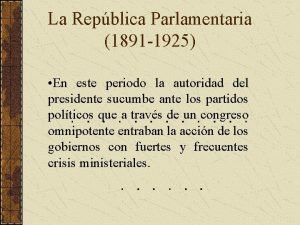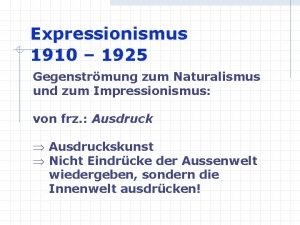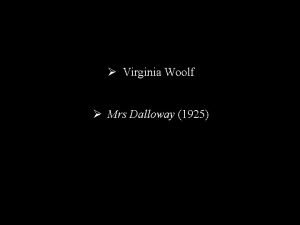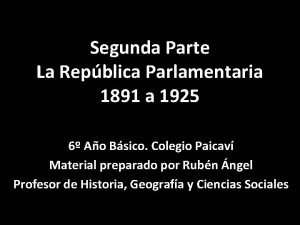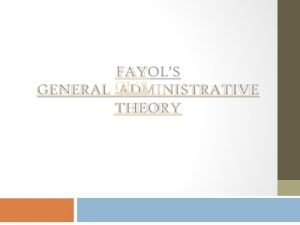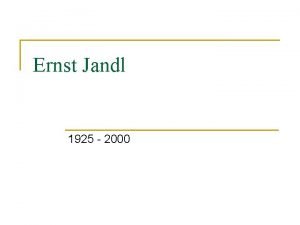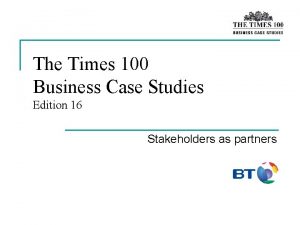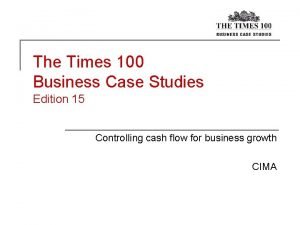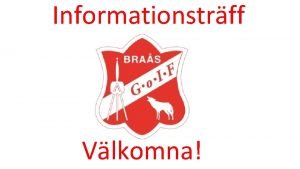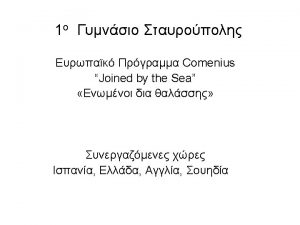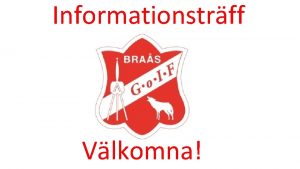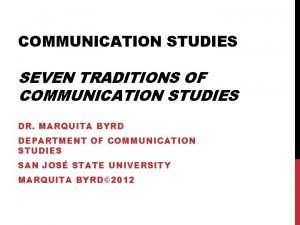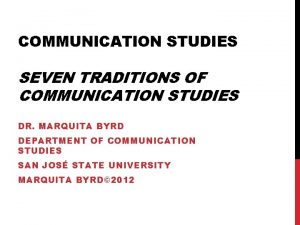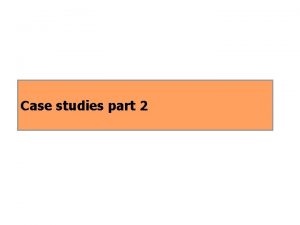Session 1925 Case Studies Military Communication II Improving






















- Slides: 22

Session 1925 Case Studies: Military Communication II Improving Wireless Network Capacity using Smart Antennas in OPNET Harkirat Singh and Suresh Singh Computer Science, Portland State University harkirat@cs. pdx. edu Copyright © 2003 OPNET Technologies, Inc. Confidential, not for distribution to third parties.

Case Studies: Military Communications II Outline § § § What is an ad hoc network Smart Antenna Overview Protocol description Implementation of the protocol within OPNET Performance study of the protocol Summary Copyright © 2003 OPNET Technologies, Inc. Confidential, not for distribution to third parties. 2

Case Studies: Military Communications II Ad Hoc Networks A B C D § Formed by co-operating wireless nodes § No fixed network infrastructure § No centralized administration - Each node acts as a router Copyright © 2003 OPNET Technologies, Inc. Confidential, not for distribution to third parties. 3

Case Studies: Military Communications II MAC in Wireless networks § Uses MAC protocol of IEEE 802. 11 based on Carrier Sense Multiple Access with Collision Avoidance (CSMA/CA) § Basic channel access method can not combat hidden and exposed terminal problems § RTS and CTS are used to reserve the channel for the entire duration of the transmission of data (including ACK) § Physical and virtual carrier sensing is used for Collision Avoidance Copyright © 2003 OPNET Technologies, Inc. Confidential, not for distribution to third parties. 4

Case Studies: Military Communications II Antenna in Wireless networks § Uses Omni-Directional Mode § Limited spatial reuse of the channel A C B D If (C, D) are transmitting A & B cannot, with directional antenna simultaneous sessions are possible Copyright © 2003 OPNET Technologies, Inc. Confidential, not for distribution to third parties. 5

Case Studies: Military Communications II Smart Antennas Schematic of a smart antenna (adaptive linear array) Copyright © 2003 OPNET Technologies, Inc. Confidential, not for distribution to third parties. 6

Case Studies: Military Communications II Smart Antennas § Adaptive Antenna Arrays can direct the Radiation / receiving pattern (main lobe) towards the desired node § Signals received by multiple antennas are weighed and combined to maximize ‘SINR’ (Signal-to-Interference plus Noise ratio) § Weight Vectors obtained will give information about the desired node position § Weight Vectors can be computed to ‘Null’ undesired signals Copyright © 2003 OPNET Technologies, Inc. Confidential, not for distribution to third parties. 7

Case Studies: Military Communications II Smart Antennas Received Power (Transmit power) *(Tx Gain) * (Rx Gain) Directional gain is higher, with Nulling Rx Gain can be negligible Copyright © 2003 OPNET Technologies, Inc. Confidential, not for distribution to third parties. 8

Case Studies: Military Communications II Example (Beamforming) Antenna pattern with 8 antenna elements Desired=45 deg, Nulls=20, 70 deg Desired=45 deg, Nulls=10, 20, 30, 70, 80, 90 deg Copyright © 2003 OPNET Technologies, Inc. Confidential, not for distribution to third parties. 9

Case Studies: Military Communications II Protocol Description § Direction-of-Arrival (DOA)-ALOHA is based on Slotted. ALOHA protocol DOA Minislot ACK Minislot DATA Transmission D B C A F E Copyright © 2003 OPNET Technologies, Inc. Confidential, not for distribution to third parties. Node ‘A’ receives max power from node ‘B’ hence places main lobe towards B and Nulls towards D & F 10

Case Studies: Military Communications II Protocol Description § § The largest minislot is for the data transmission Receiver rejects the packet if not an intended destination Receiver sends ACK if data correctly received Sender performs back-off if no ACK received (similar to Slotted-ALOHA) § Do not do Collision Avoidance (CA) but exploit Nulling! Copyright © 2003 OPNET Technologies, Inc. Confidential, not for distribution to third parties. 11

Case Studies: Military Communications II Implementation of the protocol within OPNET § Adaptive Antenna Array is implemented in Matlab and antenna module calls the Matlab routines § A node has no packet scheduled for transmission issues a remote interrupt to antenna to compute weights for omni-direction mode § Transmitter MAC calls antenna module with desired direction which invokes Matlab routines to determine weights Copyright © 2003 OPNET Technologies, Inc. Confidential, not for distribution to third parties. 12

Case Studies: Military Communications II Implementation of the protocol within OPNET § During the duration of the DOA-Minislot, dra-power pipeline stage computes the direction and the received power of all the signals § Antenna module inserts (pw, dir) pair in a dynamic list § Max power direction is the desired direction and all the other received signals are interfereres § Antenna module invokes Matlab routine with input parameter (desired_DOA, interferers) and returns new weights § We use Minimum Mean Square Error ( MMSE) algorithm for Nulling Copyright © 2003 OPNET Technologies, Inc. Confidential, not for distribution to third parties. 13

Case Studies: Military Communications II Power (in d. B) MUSIC Spatial Spectrum - Receiver Direction of Arrival (DOA) deg Copyright © 2003 OPNET Technologies, Inc. Confidential, not for distribution to third parties. 14

Case Studies: Military Communications II Implementation of the protocol within OPNET c a b d a c and b d, ‘d’ mistakenly Forms a beam towards ‘a’ § If a node beamforms incorrectly in a given timeslot, it remembers that direction in single-entry cache § During next slot node ignores maximum signal strength direction, if same, it selects second strongest signal § Cache is not updated if a node correctly receives the packet and cache is reset if no signal from that direction Copyright © 2003 OPNET Technologies, Inc. Confidential, not for distribution to third parties. 15

Case Studies: Military Communications II Performance Study Simulation Parameters Background Noise + ambient Noise Propagation model -143 d. B Bandwidth 1, 000 k. Hz Data Rate 2 Mbits/s Min Frequency 2, 402 MHz Carrier Sensing Threshold Bit Error +3 d. B Maximum radio range Copyright © 2003 OPNET Technologies, Inc. Confidential, not for distribution to third parties. Free space Based on BPSK Modulation curve 250 mts 16

Case Studies: Military Communications II Aggregate Throughput (Kbps) Some Aligned Routes in Grid Sending rate (Tx) vs Aggregate Throughput Sending Rate (Kbps) Copyright © 2003 OPNET Technologies, Inc. Confidential, not for distribution to third parties. 17

Case Studies: Military Communications II Unaligned Routes in Grid Aggregate Throughput (Kbps) Sending rate (Tx) vs Aggregate Throughput Sending Rate (Kbps) Copyright © 2003 OPNET Technologies, Inc. Confidential, not for distribution to third parties. 18

Case Studies: Military Communications II “Random” Topology Aggregate Throughput (Kbps) Sending rate (Tx) vs Aggregate Throughput Sending Rate (Kbps) Copyright © 2003 OPNET Technologies, Inc. Confidential, not for distribution to third parties. 19

Case Studies: Military Communications II Summary § Power control § Impact on Routing § Extend study to multipath environments Copyright © 2003 OPNET Technologies, Inc. Confidential, not for distribution to third parties. 20

Case Studies: Military Communications II Thank You Copyright © 2003 OPNET Technologies, Inc. Confidential, not for distribution to third parties. 21

Case Studies: Military Communications II References § J. C. Liberti and T. S. Rappaport. Smart Antennas for Wireless Communications. Prentice Hall, 1999. § Nitin H. Vaidya Romit Roy Choudhury, Xue Yang, and Ramanathan. Using directional antennas for medium access control in ad hoc networks. In ACM/SIGMOBILE Mobi. Com 2002, 23 – 28 Sep 2002. § www. eas. asu. edu/~trccomm/nsf/presentations/ Mar_21_Ravi_Govindarajula. pdf § http: //www. crhc. uiuc. edu/~croy/presentation. html Copyright © 2003 OPNET Technologies, Inc. Confidential, not for distribution to third parties. 22
 Best worst and average case
Best worst and average case Strategies for improving intercultural communication
Strategies for improving intercultural communication Heisenberg 1925 paper
Heisenberg 1925 paper Mesaj expresionist apelativ
Mesaj expresionist apelativ Laulja 1920 1975
Laulja 1920 1975 Erdbau mechanik
Erdbau mechanik Henri fayol classical theory
Henri fayol classical theory Art deco 1925
Art deco 1925 1925
1925 Expressionismus 1910 bis 1925
Expressionismus 1910 bis 1925 Sms start to 1925
Sms start to 1925 Bayer empresa 1925
Bayer empresa 1925 Mrs dalloway summary
Mrs dalloway summary Rotativa ministerial definicion
Rotativa ministerial definicion Scalar chain clipart
Scalar chain clipart Leben 1925
Leben 1925 Nota de 10000 escudos
Nota de 10000 escudos Paradigm shift from women studies to gender studies
Paradigm shift from women studies to gender studies Military effective communication
Military effective communication Advantages of descriptive research
Advantages of descriptive research Times 100 case studies
Times 100 case studies The times 100 business case studies
The times 100 business case studies Holistic technology in professional ethics
Holistic technology in professional ethics








